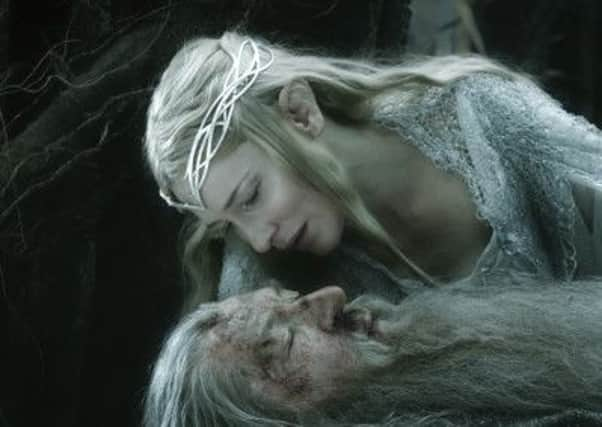Film review: The Hobbit - Battle of the Five Armies


Third time’s mostly a charm for Peter Jackson and The Hobbit. Drawing the trilogy to a close with The Battle of the Five Armies, his once interminable-seeming return to Middle-earth ends with at least some of the grandeur that made The Lord of the Rings trilogy more immediately satisfying than the first two Hobbit films.
Picking up the action moments after the The Desolation of Smaug – itself a vast improvement over the soporific An Unexpected Journey – Jackson plunges us straight into a firestorm as Smaug turns the wintry Lake-town into an inferno befitting such a seething cauldron of corruption. Swooping through overcast skies, the Benedict Cumberbatch-voiced dragon is a magnificent sight as his tail topples the rickety towers and spires of the Venetian-inspired architecture, already set ablaze by his fiery breath.
Advertisement
Hide AdUnfortunately for Smaug, he’s also still given to flapping his gums when he should be frying people to a crisp, a flaw that’s to prove his undoing this time around when he starts monologuing during a confrontation with Bard the bowman (Luke Evans) and a makeshift harpoon. Though Bard seems set to emerge as this film’s reluctant, Aragorn-esque hero, his main function is really to lead his family and fellow Lake-town refugees to the newly vacated kingdom of Erebor to seek shelter and claim the riches promised to them by the dwarf king Thorin (Richard Armitage).
Thorin has taken up his position as king of the strategically important mountain, alongside his band of fellow height-challenged reprobates and Bilbo Baggins (Martin Freeman), the titular hobbit forever being sidelined in his own story. Once again Bilbo frequently seems to disappear from the action before he’s even had a chance to slip on his precious magic ring, which is too bad: Freeman is a joy watch in the role, particularly in this instalment, which requires Bilbo to demonstrate his psychological mettle as much as his newfound bravery and nobility. Alas, until the finale he really doesn’t have all that much screen time and there’s no getting around the fact that much of The Battle of the Five Armies is pre-occupied with Thorin.
The return of the dwarf king to Erebor results in Thorin quickly becoming consumed by sickening greed and peace-threatening paranoia, which collectively acts as a plot catalyst for the remainder of the movie. Gandalf (Ian McKellen), meanwhile, is off generating yet more plot points to link The Hobbit trilogy with The Lord of the Rings, including a confrontation with a newly resurgent Sauron and a creepy showdown with some ghostly warrior knights. The latter requires the help of a Lord of the Rings all-star tag-team comprised of Galadriel (Cate Blanchett), Elrond (Hugo Weaving) and a suspiciously sprightly Saruman, played once again by Christopher Lee, digitally de-wrinkled and body-doubled so he can kick ass as if he were a member of a Middle-earth equivalent of The Expendables.
All of which functions as entertaining texture if you’re committed to looking at this as part of an overarching six-film saga. If not, it may seem a little superfluous – though if you’ve made it this far, chances are you’re already somewhat on board with Jackson’s attempt to provide as complete and immersive a narrative experience as possible. It certainly wouldn’t have made sense for him to suddenly shortchange fans at this stage by scaling back his many embellishments for the sake of brevity or linearity. He may be asking a lot of audiences to keep in their heads an array of characters and plot points from two previous Hobbit films and a trilogy of movies released over a decade ago, but the sincerity of his intent always shines through; he’s not Michael Bay blithely cranking out endless spectacle.
That’s clear from The Battle of the Five Armies itself. Significantly expanded from the few paragraphs of prose Tolkien provided, it’s a full-on carnival of combat featuring elves, dwarves, humans, two types of orc, giant earth-devouring worms, war bats, eagles and some colossal grizzly bears – all kicked into gear by a hog-riding Billy Connolly leading a dwarf army charge like a bambot Braveheart. It’s spectacular and stirring stuff, well paced and interlaced with good character drama and some astonishing imagery. Whether he’s capturing the ground-level panic that erupts when defeat looks to be upon the Lake-town refugees or subtly staining a frozen waterfall with spilled blood after a particularly brutal slaying, Jackson repeatedly demonstrates his masterful ability to marry the biggest moments with the smallest details. He may have intermittently lost his storytelling footing over the course of these three films, but with The Battle of the Five Armies he gets there in the end.